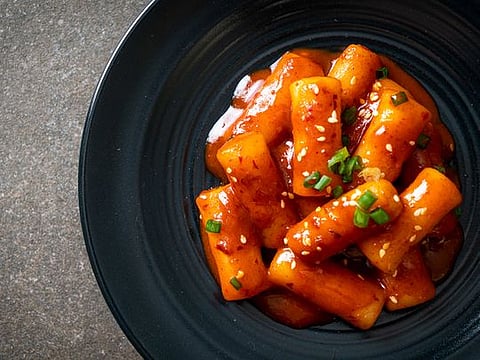The fiery rise of tteokbokki: From royal roots to Korea's iconic street food star
Why tteokbokk is a cultural icon from Korea's past to present

You might have difficulty in pronouncing it, but you won't have any trouble eating it.
That's the joy of tteokboki, chewy rice cakes bathed in a spicy, sweet sauce. And like most Korean foods, it has a story rich as its flavour, a tale that journeys from royal kitchens through war-torn streets to the vibrant heart of Korea’s street food scene.
From palace plates to street stalls: The royal beginnings
Like many Korean foods, it's a tale as old as time, and perhaps just as spicy.
As Jeon Yong-pil, Director of the Dubai branch of the Korea Agro-Fisheries and Food Trade Corporation, tells us, tteokbokki’s origins trace back to a very different era and style during the Joseon Dynasty. It wasn't the fiery street food we know today, instead, it was known as gungjung tteokbokki, a refined court dish crafted for royalty. This version was savoury and rich, made with soy sauce, tender beef, and fresh vegetables. There was no heat, only deep umami that delighted the royal palate during elaborate banquets.
At that time, red chili peppers had not yet found their way into Korean cooking. Although introduced from the Americas through trade routes in the late 16th century, chili peppers didn’t become an integral part of Korean cuisine until the 18th century. Until then, flavours came primarily from ganjang (Korean soy sauce), sesame oil, and garlic, a point well documented by food historian Michael Pettid in Korean Cuisine: An Illustrated History.
The important ingredient in the chewy rice cakes known as garae-tteok, were typically sliced lengthwise and stir-fried alongside beef or other proteins. Combined with vegetables and tossed in a lightly glossy, soy-based sauce, the dish was both luxurious and intricate. Meat was an expensive ingredient, and the careful preparation and elegant presentation reflected the refined aesthetics of the royal kitchen.
Gradually, this milder, regal tteokbokki filtered down from the palace to the homes of the yangban, Korea’s noble class. It became a comforting dish, served during ancestral rites and festive occasions—a delicious thread linking Korea’s past with its present.
The post-war twist
Yong-pil explains,after the Korean War from 1950-1953, food scarcity was a real challenge. In the early 1950s, as Seoul began to rebuild, a street vendor took the traditional gungjung tteokbokki—a soy sauce-based rice cake dish—and introduced gochujang (fermented red chili paste), which had become more widely accessible by that time.
And so, the dish was transformed into a spicy, sweet and savoury street snack that was affordable, filling and deeply satisfying. This new tteokbokki appeared to capture spirit of a nation determined to rise from hardship, and brought in the warmth of tradition with the fiery zest of modern Korean identity, as both Pettid and Yong-pil explain.
This street food revolution coincided with South Korea’s rapid industrialisation and urbaniation in the decades that followed. Spicy tteokbokki became a symbol of urban hustle, offering warmth and spice to anyone needing a quick bite or a moment of comfort.
More than food: A cultural touchstone
Tteokbokki isn’t meant to be had alone. It’s a shared experience, as Yong-pil says.
One pan, many chopsticks, endless conversations.
Tteokbokki today: From pop culture to pop-up shops
From celebrity chefs to mukbang livestreams, tteokbokki is everywhere. In fact, K-Pop stars like EXO’s Chanyeol introduced his own twist: He adds soy sauce and crushed garlic, bringing a deeper, richer taste to the dish.
One dish, many dialects: Regional twists
Busan: A subtle, sweet broth
In Busan, tteokbokki simmers in a delicate radish broth. The result: A softer, more natural sweetness that plays well with chewy rice cakes.
Jeolla Province: Seafood symphony
This southern region throws in clams, squid, and even oysters—making their tteokbokki a briny, sea-kissed feast.
Gyeongsang: The Soy sauce comeback
Here, the original non-spicy version still thrives, using soy sauce for depth without the burn.
Sindang-dong, Seoul: The spicy classic
Home to the iconic spicy-sweet version, Sindang-dong’s tteokbokki features fish cakes, boiled eggs, and optional ramen noodles—extra indulgent, always satisfying.
Sign up for the Daily Briefing
Get the latest news and updates straight to your inbox



